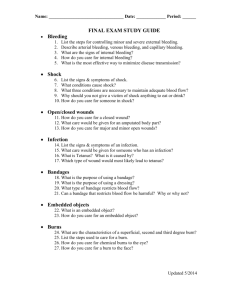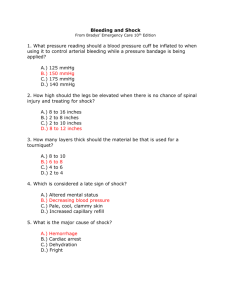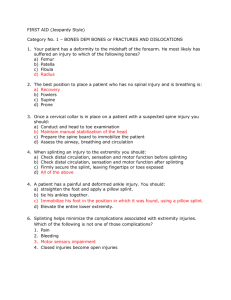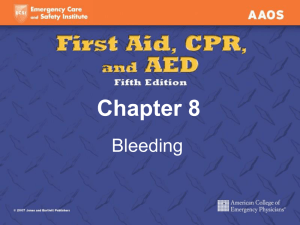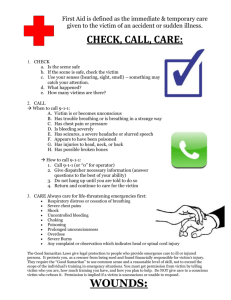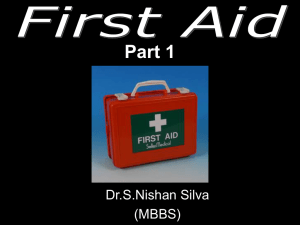Chapter 11
advertisement
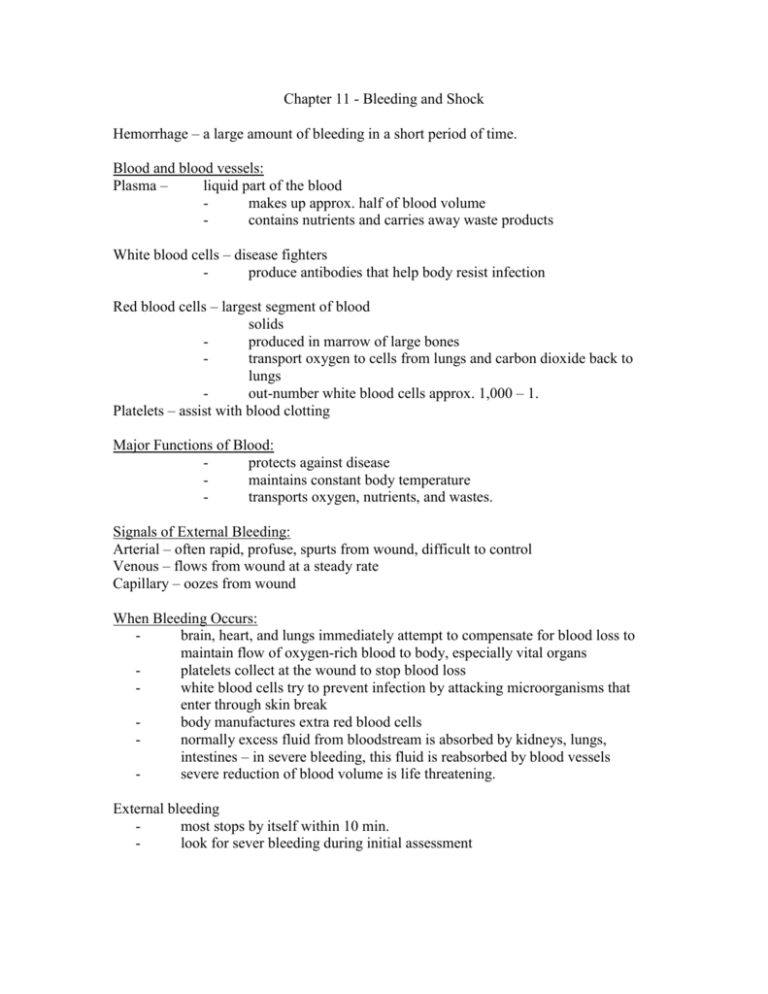
Chapter 11 - Bleeding and Shock Hemorrhage – a large amount of bleeding in a short period of time. Blood and blood vessels: Plasma – liquid part of the blood makes up approx. half of blood volume contains nutrients and carries away waste products White blood cells – disease fighters produce antibodies that help body resist infection Red blood cells – largest segment of blood solids produced in marrow of large bones transport oxygen to cells from lungs and carbon dioxide back to lungs out-number white blood cells approx. 1,000 – 1. Platelets – assist with blood clotting Major Functions of Blood: protects against disease maintains constant body temperature transports oxygen, nutrients, and wastes. Signals of External Bleeding: Arterial – often rapid, profuse, spurts from wound, difficult to control Venous – flows from wound at a steady rate Capillary – oozes from wound When Bleeding Occurs: brain, heart, and lungs immediately attempt to compensate for blood loss to maintain flow of oxygen-rich blood to body, especially vital organs platelets collect at the wound to stop blood loss white blood cells try to prevent infection by attacking microorganisms that enter through skin break body manufactures extra red blood cells normally excess fluid from bloodstream is absorbed by kidneys, lungs, intestines – in severe bleeding, this fluid is reabsorbed by blood vessels severe reduction of blood volume is life threatening. External bleeding most stops by itself within 10 min. look for sever bleeding during initial assessment Symptoms of severe bleeding: blood spurting from a wound blood that fails to clot even after you have taken all measures to control it. Controlling external bleeding: follow BSI (Body substance isolation) direct pressure elevation pressure bandage pressure point – brachial and femoral arteries continue to monitor airway and breathing if bleeding severe, administer supplemental oxygen of available and you are trained. Preventing Disease Transmission: avoid contacting the victim’s blood directly or indirectly (use gloves, protective eyewear) avoid eating and drinking and touching your mouth, nose, or eyes while providing care or before washing your hands always wash you hands thoroughly after providing care, even if you wore gloves Internal Bleeding: Suspect it in any serious injury. Severe internal bleeding will eventually produce signs of shock. These signs and symptoms may take time to appear. They include: discoloration of the skin soft tissues (like in the abdomen) that are tender, swollen, or firm anxiety or restlessness rapid, weak pulse rapid breathing skin that feels cool or moist or looks pale, ashen, or bluish nausea and vomiting excessive thirst declining level of consciousness (LOC) drop in blood pressure Controlling Internal Bleeding: if minor, apply ice if severe, need more advanced care while waiting: do no further harm monitor ABCs and vital signs help the victim rest in the most comfortable position keep the victim from getting chilled or over-heated reassure the victim provide care for other conditions administer oxygen if it is available and you are trained to do so Shock (hypoperfusion) ►a condition in which the circulatory system fails to adequately circulate oxygenrich blood to all parts of body. ►is inevitable in any serious injury or illness ►when vital organs do not receive oxygen-rich blood, they fail to function properly. ►Improper functioning triggers shock. - To maintain adequate blood flow: the heart must be working well. An adequate amount of blood must be circulating in the body. The blood vessels must be intact and able to adjust blood flow. Injury or sudden illness ca interrupt normal body functions. If minor, this interruption is brief. If more severe, the body is unable to adjust. How shock develops – see page 234 Signs & Symptoms of Shock Restlessness and irritability – best symptom Rapid and weak pulse Rapid breathing Pale, ashen, or bluish, cool, moist skin Excessive thirst Nausea and vomiting Drowsiness or loss of consciousness Drop in blood pressure. Care for Shock: Do an initial assessment and provide care for life-threatening conditions. If there are no life-threatening conditions, perform a physical exam and SAMPLE history. Then: Do not harm Monitor ABCs and provide care Help the victim rest comfortably Keep the victim from getting chilled or over-heated Reassure the victim Provide care for specific conditions You can also: Control any external bleeding ASAP Elevate the legs about 12” unless contra-indicated Administer oxygen if available and you are trained Do not give them anything to eat or drink Call for advanced medical personnel

